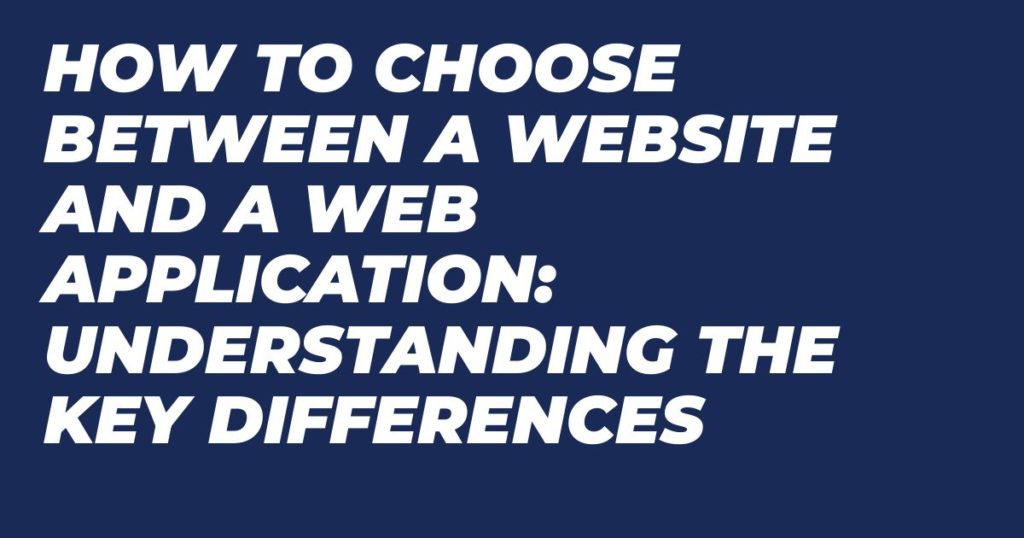How to choose between a Website and a Web Application? What’s the difference between a website and a web app?
Are you trying to determine whether a website or a web application is best for your needs?
Understanding the differences between the two is crucial in making an informed decision. Websites typically contain static content and are designed for information dissemination, while web applications are interactive, often containing business logic and serving specific user functions.

In this post, we’ll delve into the disparities between websites and web applications and explore how to choose the right option for your requirement.
The difference between website and web application
| Feature | Website | Web Application |
|---|---|---|
| Primary Purpose | Primarily informational, providing content to visitors. | Interactive, allowing users to perform tasks and actions. |
| User Interaction | Limited interaction, mainly reading or viewing content. | High level of interaction, such as inputting data, customization, etc. |
| Functionality | Usually static with fixed content, though modern websites can have dynamic elements. | Dynamic, can include complex tasks like online banking, shopping, and more. |
| User Authentication | Not typically required for accessing content. | Often requires login for personalized interaction and security. |
| Development Complexity | Generally simpler, focused on layout and content presentation. | More complex, involving server-side processing, database integration, etc. |
| Update Frequency | Content updates may not require frequent changes in the code. | Regular updates and maintenance for functionality, security, etc. |
| Back-End Development | Less emphasis on back-end development. | Heavily relies on back-end development for functionality. |
| Examples | Blog sites, news websites, corporate websites. | Online stores, social media platforms, SaaS products. |
How to Choose?
- Purpose and Goals: If you need to provide information, a website is sufficient. For interactive services, a web application is necessary.
- Budget and Resources: Websites are typically less expensive and easier to maintain. Web applications require more investment in development and maintenance.
- User Experience: Consider the level of engagement and interaction your users need. For a more engaging experience, a web application is better.
- Scalability: If you anticipate the need to scale up and add more features, a web application might be a more suitable long-term solution.
- Technical Requirements: Assess the technical needs of your project. Web applications often require more complex technologies and hosting solutions.
Understanding Websites and Web Applications
When it comes to understanding the differences between websites and web applications, it’s essential to grasp the distinct functionalities and purposes that each serves.
Below, we’ll define websites and delve into the explanation of web applications to help you differentiate between the two.
Defining Websites
Websites are digital destinations comprised of web pages containing a variety of multimedia content such as text, images, videos, and links. They serve as informational platforms, providing users with content to consume, navigate, and interact with. Websites are predominantly static in nature, as the content displayed is not personalized and does not change based on user interactions. They are primarily designed for one-way communication, delivering information to visitors without the need for user input or dynamic processing.
Explaining Web Applications
On the other hand, web applications are interactive software programs accessible via web browsers. Unlike websites, web applications are dynamic and allow users to actively engage with the platform by inputting data, receiving personalized content, and performing various tasks. They often involve databases, user authentication, and real-time updates, enabling users to carry out specific functions or transactions.
As we continue to unravel the contrasts between websites and web applications, it’s crucial to recognize their distinct features and functionalities, enabling you to make informed decisions when determining the most suitable platform for your specific needs.
Distinguishing Features
When deciding between a website and a web application, it’s essential to understand their distinguishing features. Each has unique characteristics that cater to specific purposes and user needs.
Interactivity and Functionality
Websites primarily focus on providing information or content to visitors. They are predominantly informational and may offer limited interactivity. In contrast, web applications are designed for interactivity and functionality, allowing users to perform specific tasks, engage in complex interactions, and manipulate data. For example, while a website may display information about a company’s products, a web application enables users to customize and purchase these products directly on the platform.
Websites typically serve as a one-way communication channel, whereas web applications facilitate two-way interaction, often incorporating user inputs, processing data, and delivering personalized outputs.
Data Management and Processing
Another key distinction lies in data management and processing. Websites are generally static in nature, with content that remains constant across visits. They are designed to disseminate information, and any data manipulation or processing occurs outside the website. On the other hand, web applications are dynamic and capable of handling, storing, and processing user-generated data. They often integrate databases and conduct real-time data processing to deliver personalized experiences and tailored results.
Web applications have the capacity to store user preferences, transaction history, and custom settings, offering a more personalized and adaptive user experience.
User Experience and Customization
The user experience on a website typically revolves around browsing and consuming content. While websites may offer some degree of personalization, they are generally less tailored to individual user preferences and behaviors. Web applications, however, focus on delivering highly customized experiences, adapting functionality and content based on user input and behavior.
Web applications often feature user accounts, personalized dashboards, and tailored recommendations, leveraging user data to enhance the overall experience.
By understanding these distinguishing features in terms of interactivity and functionality, data management and processing, and user experience and customization, you can make an informed decision when choosing between a website and a web application.
Choosing Between a Website and a Web Application
When deciding between a website and a web application, it’s crucial to consider various aspects that align with your goals and resources. Understanding the purpose, budget, scalability, and future development requirements will lead to an informed decision.
Purpose and Objectives
Clarifying the purpose and objectives of your online presence is the first step in choosing between a website and a web application. If your goal is to showcase information and establish an online presence, a website might suffice.
On the other hand, if interactivity, data processing, and complex functionalities are integral to your objectives, a web application would be more suitable. Consider how you want users to engage with your online platform and what specific features are essential to accomplishing your objectives.
Budget and Resources
Budget and resources play a significant role in deciding between a website and a web application. Websites are generally more cost-effective to develop and maintain, making them suitable for businesses with limited resources.
In contrast, web applications often require more extensive development resources, including backend databases, API integrations, and ongoing maintenance. Assess your budget and available resources to make an informed choice that aligns with your financial capabilities.
Scalability and Future Development
Considering future scalability and development needs is crucial when choosing between a website and a web application. Websites can be easily scaled by adding new pages or features, while web applications can accommodate complex user interactions and large datasets. If you anticipate rapid growth or the need for advanced functionalities in the future, a web application might be a more sustainable choice. Evaluate the long-term vision for your online platform and anticipate the potential need for scalability and advanced features.
By carefully evaluating the purpose and objectives, budget and resources, scalability and future development requirements, you can decide whether a website or web application best aligns with your needs and goals.
For more insight into this topic, you might find additional guidance from reputable sources to support your decision-making process further.
Key Considerations for Businesses and Individuals
When considering whether to build a website or a web application, it’s important to take into account the needs and preferences of your target audience. Both businesses and individuals should prioritize understanding their target audience and how they engage with digital platforms.
Target Audience and User Engagement
Understanding your target audience is crucial when making the decision between a website and a web application. For businesses, it’s essential to consider the demographics, preferences, and technological proficiency of your potential users. Individuals should also consider the needs and habits of the intended audience for their online presence.
User engagement is another key factor. How do you want your audience to interact with your digital platform? Whether it’s through simple browsing, active participation, or complex task completion, understanding user engagement needs will guide the decision-making process.
Functional Requirements and Complexity
The functional requirements of your project play a significant role in determining whether a website or a web application is more suitable. For businesses, this involves assessing the essential features and capabilities needed to achieve business goals. Individuals should consider the functionalities required to showcase their content or offer services effectively.
Additionally, consider the complexity of the project. Will your digital platform require dynamic interaction, real-time data processing, or complex algorithms? Assessing the complexity of the required functionalities will help in making an informed decision.
Long-Term Viability and Growth
Long-term viability and growth are crucial considerations. For businesses, it’s essential to assess how the chosen digital platform aligns with the company’s long-term objectives and scalability. Individuals should also consider the potential for expansion and evolution of their online presence over time.
It’s important to evaluate whether the chosen approach can accommodate future enhancements, technological advancements, and scaling requirements. Assessing long-term viability and growth potential will contribute to the sustainability of your digital platform.
Consider these key factors when deciding between a website and a web application, as they will directly impact the success and effectiveness of your digital presence.
Conclusion
Understanding the fundamental differences between a website and a web application is crucial for making informed decisions about your online presence. In this article, we’ve explored the defining characteristics of each, including their functionality, interactivity, and user experience.
We’ve highlighted the key distinctions, such as the dynamic nature of web applications, their ability to handle complex tasks, and their reliance on databases to deliver real-time, interactive experiences. On the other hand, websites primarily focus on presenting static content with limited interactivity.
When considering whether to choose a website or a web application, it’s essential to evaluate your specific needs and goals. Web applications are suitable for complex functionalities, user interactivity, and dynamic content management, making them ideal for businesses requiring interactive tools, e-commerce platforms, and data-driven applications. On the other hand, websites are well-suited for static content, informational platforms, and online brochures.
Ultimately, the decision comes down to understanding your unique requirements and the type of experience you want to offer your audience. Professional advice can be invaluable in making this critical choice.
By grasping the nuances between websites and web applications, you’ll be better equipped to align your online strategy with your objectives and cater to your audience’s needs effectively. Ultimately, the right decision will empower you to create a compelling online presence that resonates with your target audience and drives your desired outcomes.




